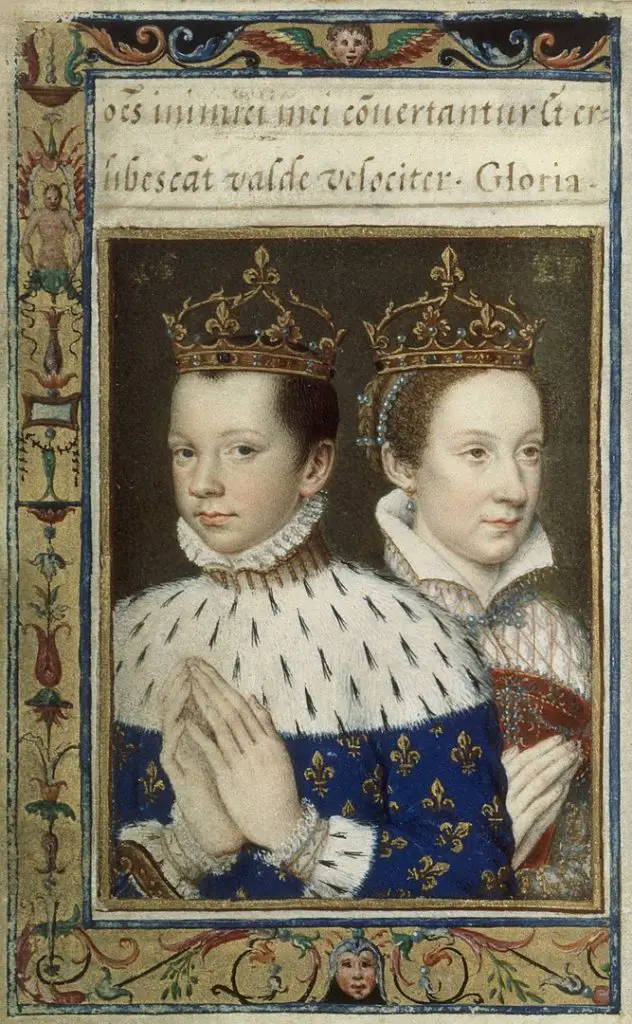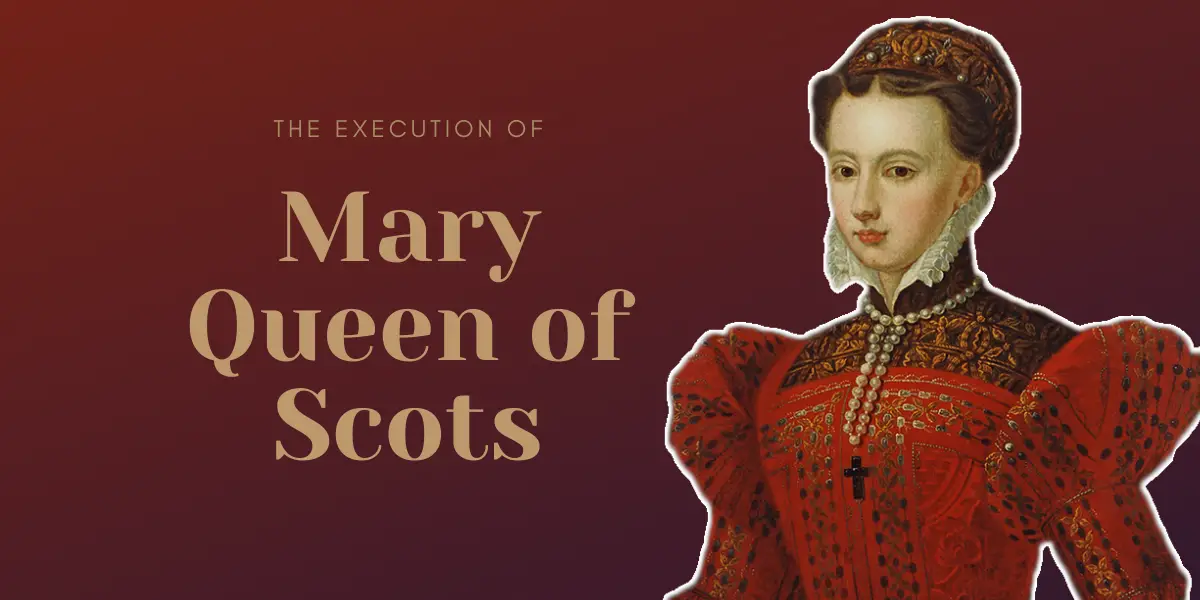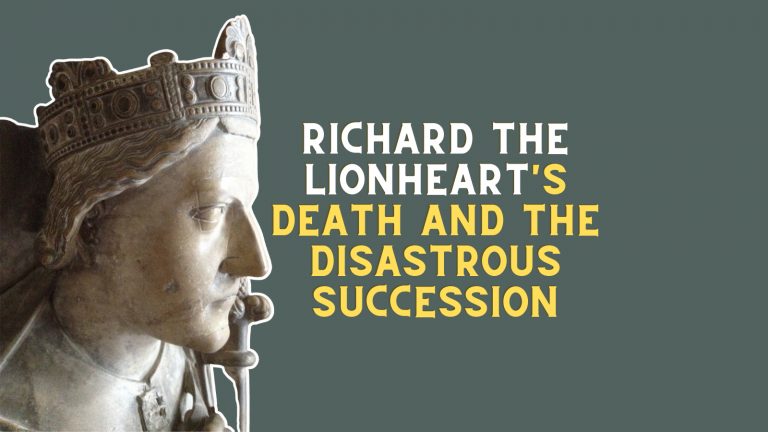The Execution of Mary Queen of Scots
The execution of Mary Queen of Scots on the 8th of February 1587 at Fotheringhay Castle in Northamptonshire is one of the most infamous botched beheadings in British history.
It was one of the most dramatic events in the Tudor era. It was the end game of many years of rivalry between Mary Queen of Scots and Queen Elizabeth I of England.
In the video below, Henry VIII tells the grisly tale in all of its gruesome glory. A story that ends with the immortal words, “So perish all the queen’s enemies.” If you prefer, read on to find out the events behind this power play for the English throne.
The Early Life of Mary Queen of Scots
Mary Stuart was the Queen of Scotland. She had been Queen there since she was just six days old. She was a Catholic, and she spent most of her early life being brought up in France at the French court.
Mary Queen of Scots had a claim on the English throne, being the granddaughter of Henry VIII’s elder sister Margaret Tudor and, therefore, the great-granddaughter of Henry VII of England.
When her first husband, King Francis II of France, died, Mary returned to Scotland.
As a young woman, she encountered problems trying to rule. The most significant of which was that most of the Scottish Lords were Protestant. They didn’t look too favourably on the young catholic Scottish Queen telling them what to do. They preferred the Protestant regent, Mary Stuart’s half-brother, The Earl of Moray, to lead the government.
Further problems occurred with both the Scottish Lords and her cousin Queen Elizabeth I when she married Henry, Lord Darnley. Darnley himself was one of the possible claimants to the English Throne on Queen Elizabeth’s death. Elizabeth believed the marriage only strengthened Mary Queen of Scot’s hand when it came to her own claims to her throne.
Darnley thought that he should really sit on the Scottish throne as he was married to the Scottish Queen. The Scottish lords didn’t really like this. It didn’t help that Darnley was a womanizer and a drunk. However, Mary did fall pregnant. On 19 June 1566, she gave birth to a boy who she named James.
Again, this strengthened Mary Queen of Scots’ hand when it came to succeeding Queen Elizabeth.

Mary Queen of Scots and her first husband, Francais II, King of France.
The murder of Lord Darnley
Darnley became more and more controlling. During Mary’s pregnancy, he arranged the murder of her private secretary, David Rizzio. Rizzio was stabbed to death in front of Mary by Darnley and his supporters. The body had 57 stab wounds.

The Murder of David Rizzio by Opie
It was the beginning of the end for the marriage and of Darnley himself.At around 2 AM on the 10th February 1567, the house he had been staying in at Kirk O Field exploded. Darnley’s dead body was found the following day in the orchard without a single burn upon it. He’d been strangled. It was murder.
Mary immediately made the problem worse by marrying the man who was the chief suspect in the crime, The Earl of Bothwell.
Elizabeth was enraged by this move and suggested that her cousin had a hand in her husband’s murder. Historians now believe that the Earl of Bothwell probably forced Mary of Queen of Scots to marry him against her will.
Mary Stuart’s loss of the Scottish throne
The Scottish lords agreed with Queen Elizabeth I‘s assessment of the situation. They believed that Mary Queen of Scots was involved in the murder of her husband.
A rebellion soon occurred, which the Scottish lords won. Bothwell was allowed to flee the country as part of the deal he negotiated. The Protestant Lords took Mary Queen of Scots prisoner. She was imprisoned in Loch Leven Castle in the middle of the loch.
They forced her to abdicate the throne in favour of her young son, James.
Mary’s son, James, became King James VI of Scotland.
On hearing this news, Queen Elizabeth of England was once again enraged. Despite her feelings about Mary Queen of Scots’ role in the murder of her husband, she did not believe that subjects should be able to remove an anointed sovereign. Elizabeth’s great fear was that if it could be done in Scotland, it could happen in England.
Mary always had a captivating way about her, especially when it came to men. She managed to charm the guards in the castle. Miraculously, Mary escaped the castle.
Nowhere in Scotland could provide safety for her, so she fled to the one place where she thought she would be safe: her cousin Elizabeth’s realm of England.
The Imprisonment of Mary Queen of Scots In England
Elizabeth promptly locked Mary Queen of Scots up. However, she didn’t quite call it that.
She confined her to various castles and country houses in England’s north and midlands.
Why did Elizabeth do this? Because Mary always claimed that she was the rightful Queen of England.

The image shows Tutbury Castle in Staffordshire – Frequently quoted as the most hated prison of Mary Queen of Scots. @historywithhenry.
The argument Mary had, which was supported by the catholic church, was that Elizabeth was illegitimate. King Henry VIII had made her so when he nullified his marriage to Anne Boleyn before her execution.
Mary just saw a kingdom ripe for the taking, especially as Elizabeth had no male heir. Many of the secret Catholics in the north of England supported Mary Queen of Scots’ claim to the throne. Mary believed that one day, they would rise up and make her the English Queen.
For the next 16 years, Mary plotted every day against Elizabeth’s life.
Finally, Elizabeth’s spymaster, Sir Francis Walsingham, captured some letters written in Mary’s own hand. They were written in code, but they were deciphered.
The contents leave the readers in no doubt that Mary is plotting against Elizabeth’s life. This plot became known as the Babington Plot.

The Trial of Mary Queen of Scots
Finally, Walsingham had the evidence he needed.
Mary was formally arrested on the 11th of August 1586. She actually believed that the men behind the Babington Plot were coming to help her escape; however, it was Queen Elizabeth’s men, and she was taken into custody.
Mary Queen of Scots went on trial.
She argued that as a foreign anointed queen, she was not Elizabeth’s subject and, therefore, could not be convicted of treason.
Unsurprisingly, she was found guilty of high treason on the 25th of October. She was sentenced to death.
Queen Elizabeth’s refusal to sign the execution warrant
Elizabeth wavered on signing the execution warrant.
Why?
She didn’t want the blood of her cousin, a fellow anointed sovereign, on her own hands.
However, she wrote to Mary Queen of Scot’s “prison guard” Paulet at Fotheringhay Castle, essentially asking him to “shorten the life” of Mary. In other words, she was asking him to secretly murder Mary Queen of Scots to prevent her from having to sign the execution warrant.
He refused.
And then, finally, after days and weeks of persuasion by her counsellors, Elizabeth signed the warrant. It immediately got rushed up to Fotheringhay Castle.
The preparations for the execution of Mary Queen of Scots
The execution warrant arrived at eight-thirty at night. The Earls of Shrewsbury and Kent marched into Mary’s Stuart’s room. They pulled down the cloth of estate that went over her chair, and they informed the Scottish Queen that she would die the following day.
Mary immediately began making preparations. She started giving away all of her goods to her loyal servants. She sat down and wrote one final letter to the King of France, where she urged him to look out for her son, King James, who she believed had forsaken her.
Mary Queen of Scots spent most of the evening awake and at prayer, preparing herself for death.
Meanwhile, a scaffold was being built down in the great hall of Fotheringhay Castle.
The drama preceding the execution of Mary Queen of Scots
Early in the morning, Mary emerged from her chambers dressed in a coat of pure black.
After an emotional final farewell to her servants, she walked into the great hall of Fotheringay castle.
A silence fell.
All of the Gentry of Northamptonshire had been summoned overnight to witness Mary’s execution. She climbed a small scaffold that had been constructed overnight and draped in black.
She took her seat in the middle. The Earls of Shrewsbury and Kent took their places, and the execution of the warrant was read out loud.
Then, the Dean of Peterborough started to attempt to preach a sermon in a very loud voice. Mary Queen of Scots shouted him down, saying that she was settled in the Catholic religion and she would not hear what she considered to be heresy.
So the Dean moved on to the prayers…
Then a very bizarre scene unfolded with Mary, and a handful of servants, attempting to shout out the Dean, with their own Catholic prayers in Latin. The Dean raised his voice louder, still saying his prayers in English. It became a battle of wills, which ultimately Mary won.
At this point, the executioners came forward. A man called Bull and his assistant had been dispatched from the Tower of London, specifically for this task. They knelt before Mary Queen of Scots and asked her forgiveness; she said, “I hope that you will make an end of all of my troubles.”
Mary Stuart then removed her outer garments with the executioners assisting the servants. Mary laughed and joked that never in her life had she had such a groom.
Then a loud, audible gasp went all the way around the Great Hall of Fotheringhay Castle.
Mary Queen of Scots removed her black coat to reveal a low-cut scarlet petticoat.
Scarlet was the Catholic colour of martyrdom.
What Mary was saying was she was about to die for the Catholic cause and the Catholic religion.
The execution of Mary Queen of Scots
The execution of Mary Queen of Scots was now ready to finally take place.
Mary Stuart said one final prayer in Latin.
She nodded, and one of her ladies came forward and blindfolded her with a white handkerchief. Mary leaned forward, placed her head on the block, and raised her arms to signify she was ready.
The executioner lifted the axe and brought it down right in the middle of the back of their head.
Mary Queen of Scots left out a small gasp of pain, and Bull pulled the axe out. He took aim for a second time, and this time, he brought it down on Mary Stuart’s neck.
However, her neck wasn’t yet severed.
The executioner resorted to using his axe, like a butcher’s meat cleaver, to cut through the final sinews of flesh and muscle.
Finally, the head fell to the floor. The executioner bent down, picked the head from the scaffold by the hair and held it aloft to the crowd. As he did so, the lips stirred. Bull uttered the immortal words, “So perish all the queen’s enemies.”
At this point, Mary Queen of Scots’ head fell from his hand, leaving her hair in his hands.
Why?
Mary Stuart was almost entirely bald, and she was wearing her best wig to attend her own execution.
Mary Queen of Scots’ Dog
The block, Mary Stuart’s clothing, and all of the drapes on the scaffold were burnt, so there was no relics of martyrdom that could possibly make their way out into the kingdom.
They came to move Mary Queen of Scot’s dead body. There, in the folds of her underskirt, they found her little dog pining for its mistress.
Mary Queen of Scot’s Burial in Westminster Abbey
Mary was initially buried in Peterborough Cathedral, the resting place of Catherine of Aragon. However, when Mary’s son, King James I of England and VI of Scotland, succeeded Elizabeth, he had his mother exhumed and reburied in Westminister Abbey.
The execution of Mary Queen of Scots remains one of the most infamous events in British history and a story that should never be forgotten.






